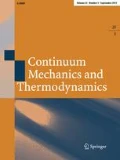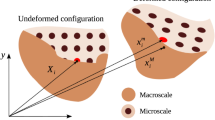Abstract
Today it is well known that the classical Cauchy continuum theory is insufficient to describe the deformation behavior of solids if gradients occur over distances which are comparable to the microstructure of the material. This becomes crucial e.g., for small specimens or during localization of deformation induced by material degradation (damage). Higher-order continuum approaches like micromorphic theories are established to address such problems. However, such theories require the formulation of respective constitutive laws, which account for the microstructural interactions. Especially in damage mechanics such laws are mostly formulated in a purely heuristic way, which leads to physical and numerical problems. In the present contribution, the fully micromorphic constitutive law for a porous medium is obtained in closed form by homogenization based on the minimal boundary conditions concept. It is shown that this model describes size effects of porous media like foams adequately. The model is extended toward quasi-brittle damage overcoming the physical and numerical limitations of purely heuristic approaches.
Similar content being viewed by others
References
Eringen A.C., Suhubi E.S.: Nonlinear theory of simple micro-elastic solids—I. Int. J. Eng. Sci. 2(2), 189–203 (1964)
Lakes R.S.: Size effects and micromechanics of a porous solid. J. Mater. Sci. 18(9), 2572–2580 (1983)
Lakes R.S.: Experimental microelasticity of two porous solids. Int. J. Solids Struct. 22(1), 55–63 (1986)
Tekoğlu C., Gibson L., Pardoen T., Onck P.: Size effects in foams: experiments and modeling. Prog. Mater. Sci. 56(2), 109–138 (2011)
Branke, D.: Homogenisierungsmethode für den Übergang vom CAUCHY- zum COSSERAT-Kontinuum. Dissertation; TU Dresden (2012)
Tekoğlu C., Onck P.R.: Size effects in two-dimensional Voronoi foams: a comparison between generalized continua and discrete models. J. Mech. Phys. Solids 56(12), 3541–3564 (2008)
de Borst R., Sluys L., Muhlhaus H.B., Pamin J.: Fundamental issues in finite element analyses of localization of deformation. Eng. Comput. 10(2), 99–121 (1993)
Forest S., Sab K.: Cosserat overall modeling of heterogeneous materials. Mech. Res. Commun. 25(4), 449–454 (1998)
Jänicke R., Diebels S., Sehlhorst H.G., Düster A.: Two-scale modelling of micromorphic continua. Continuum Mech. Thermodyn. 21(4), 297–315 (2009)
Jänicke R., Steeb H.: Wave propagation in periodic microstructures by homogenisation of extended continua. Comput. Mater. Sci. 52(1), 209–211 (2012)
Zybell L., Mühlich U., Kuna M.: Constitutive equations for porous plane-strain gradient elasticity obtained by homogenization. Arch. Appl. Mech. 79(4), 359–375 (2009)
Gologanu, M., Leblond, J., Perrin, G., Devaux, J.: Recent extensions of Gurson’s model for porous ductile metals. In: Suquet, P., (ed.) Continuum micromechanics. No. 377 in Cism Courses And Lectures: International Centre For Mechanical Sciences Series, pp. 61–130. Springer, New York (1997)
Bigoni D., Drugan W.J.: Analytical derivation of Cosserat moduli via homogenization of heterogeneous elastic materials. J. Appl. Mech. 74(4), 741–753 (2006)
Yuan X., Tomita Y., Andou T.: A micromechanical approach of nonlocal modeling for media with periodic microstructures. Mech. Res. Commun. 35(1–2), 126–133 (2008)
Li J.: Establishment of strain gradient constitutive relations by homogenization. Comptes Rendus Mécanique 339(4), 235–244 (2011)
Forest S.: Micromorphic approach for gradient elasticity, viscoplasticity, and damage. J. Eng. Mech. 135(3), 117–131 (2009)
Forest, S., Ammar, K., Appolaire, B.: Micromorphic vs. phase-field approaches for gradient viscoplasticity and phase transformations. In: Markert B., (ed.) Advances in Extended and Multifield Theories for Continua; Lecture Notes in Applied and Computational Mechanics, vol. 59, pp. 69–88. Springer, Berlin (2011)
Hütter G., Linse T., Mühlich U., Kuna M.: Simulation of ductile crack initiation and propagation by means of a non-local GTN-model under small-scale yielding. Int. J. Solids Struct. 50, 662–671 (2013)
Forest S., Sievert R.: Nonlinear microstrain theories. Int. J. Solids Struct. 43(24), 7224–7245 (2006)
Germain P.: The method of virtual power in continuum mechanics. Part 2: microstructure. SIAM J. Appl. Math. 25(3), 556–575 (1973)
Forest S.: Homogenization methods and the mechanics of generalized continua—part 2. Theor. Appl. Mech. 28-29, 113–143 (2002)
Forest S., Trinh D.K.: Generalized continua and non-homogeneous boundary conditions in homogenisation methods. Z. Angew. Math. Mech. 91(2), 90–109 (2011)
Jänicke R., Steeb H.: Minimal loading conditions for higher order numerical homogenisation schemes. Arch. Appl. Mech. 82(8), 1075–1088 (2012)
Forest S. : Mechanics of Cosserat media—an introduction. Ecole des Mines de Paris, Paris (2005)
Jänicke, R.: Micromorphic media: interpretation by homogenisation. Dissertation; Universität des Saarlandes; Saarbrücken (2010)
Mühlich U., Zybell L., Kuna M.: Estimation of material properties for linear elastic strain gradient effective media. Eur. J. Mech. A-Solid 31(1), 117–130 (2012)
Aifantis E.C.: The physics of plastic deformation. Int. J. Plast. 3(3), 211–247 (1987)
Forest S.: Questioning size effects as predicted by strain gradient plasticity. J. Mech. Behav. Mater. 22, 101–110 (2013)
Aifantis K.E., Willis J.R.: The role of interfaces in enhancing the yield strength of composites and polycrystals. J. Mech. Phys. Solids 53(5), 1047–1070 (2005)
Mazière, M., Forest, S.: Strain gradient plasticity modeling and finite element simulation of Lüders band formation and propagation. Continuum Mech. Thermodyn. (2013). doi:10.1007/s00161-013-0331-8
Mühlich U., Zybell L., Hütter G., Kuna M.: A first-order strain gradient damage model for simulating quasi-brittle failure in porous elastic solids. Arch. Appl. Mech. 83, 955–967 (2013)
Waseem A., Beveridge A., Wheel M., Nash D.: The influence of void size on the micropolar constitutive properties of model heterogeneous materials. Eur. J. Mech. A-Solid 40, 148–157 (2013)
Jänicke R., Sehlhorst H.G., Duster A., Diebels S.: Micromorphic two-scale modelling of periodic grid structures. Int. J. Multiscale Comput. Eng. 11(2), 161–176 (2013)
Lemaitre J., Chaboche J.L.: Mechanics of Solid Materials. Cambridge University Press, Cambridge (1994)
Geers M.G.D., Borst R.de, Brekelmans W.A.M., Peerlings R.H.J.: Strain-based transient-gradient damage model for failure analyses. Comput. Methods Appl. Mech. Eng. 160(1–2), 133–153 (1998)
Geers M.G.D., Peerlings R.H.J., Brekelmans W.A.M., Borst R.de : Phenomenological nonlocal approaches based on implicit gradient-enhanced damage. Acta Mech. 144(1), 1–15 (2000)
Dimitrijevic B.J., Hackl K.: A method for gradient enhancement of continuum damage models. Tech. Mech. 28(1), 43–52 (2008)
Jirásek M.: Nonlocal models for damage and fracture: comparison of approaches. Int. J. Solids Struct. 35(31–32), 4133–4145 (1998)
Simone A., Wells G.N., Sluys L.J.: From continuous to discontinuous failure in a gradient-enhanced continuum damage model. Comput. Methods Appl. Mech. Eng. 192(41–42), 4581–4607 (2003)
Author information
Authors and Affiliations
Corresponding author
Additional information
Communicated by Andreas Öchsner.
Rights and permissions
About this article
Cite this article
Hütter, G., Mühlich, U. & Kuna, M. Micromorphic homogenization of a porous medium: elastic behavior and quasi-brittle damage. Continuum Mech. Thermodyn. 27, 1059–1072 (2015). https://doi.org/10.1007/s00161-014-0402-5
Received:
Accepted:
Published:
Issue Date:
DOI: https://doi.org/10.1007/s00161-014-0402-5




